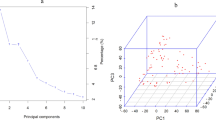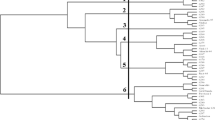Abstract
Bermudagrass [Cynodon dactylon (L.) Pers.] is a perennial and typical warm-season grass. It undergoes withering and severe damage under cold stress; thus, cold is considered as a key factor that restricts the widespread use in bermudagrass. Identification of association between molecular markers and cold tolerance-related traits would facilitate the efficient selection of cold tolerant bermudagrass cultivars. A total of 106 diverse bermudagrass accessions, including 4 commercial cultivars and 102 wild germplasms, were tested for cold tolerance and analyzed by 104 simple sequence repeat (SSR) markers. Cold significantly decreased transpiration rate, growth rate and turf quality. There were significant variations in these trait values among the accessions under cold conditions. Two subpopulations were detected in the panel of accessions based on the analysis of 1474 alleles with 104 SSR markers. Clustering analysis revealed that the genetic relationship was affected by the natural habitats. Thirty-four SSR markers were identified to be associated with two or three traits based on the corrected P values (P < 3.5 × 10−4). These markers can be used for genetic improvement of cold tolerance of bermudagrass after further validation.




Similar content being viewed by others
References
Anderson JA, Taliaferro CM, Martin DL (1993) Evaluating freeze tolerance of bermudagrass in a controlled environment. Hortic Sci 28:955–959
Aranzana MJ, Kim S, Zhao K, Bakker E, Horton M, Jakob K (2005) Genome-wide association mapping in Arabidopsis identifies previously known flowering time and pathogen resistance genes. PLoS Genet 1:e60
Atwell S, Huang YS, Vilhjálmsson BJ, Willems G, Horton M, Li Y (2010) Genome-wide association study of 107 phenotypes in Arabidopsis thaliana inbred lines. Nature 465:627–631
Baek KH, Skinner DZ (2003) Alteration of antioxidant enzyme gene expression during cold acclimation of near-isogenic wheat lines. Plant Sci 165:1221–1227
Båga M, Chodaparambil SV, Limin AE, Pecar M, Fowler DB, Chibbar RN (2007) Identification of quantitative trait loci and associated candidate genes for low-temperature tolerance in cold-hardy winter wheat. Funct Integr Genomics 7:53–68
Breseghello F, Sorrells ME (2006) Association mapping of kernel size and milling quality in wheat (Triticum aestivum L.) cultivars. Genetics 172:1165–1177
Burke MJ, Gusta LV, Quamme HA, Weiser CJ, Li PH (1976) Freezing and injury in plants. Annu Rev Plant Physiol 27:507–528
Caetano-Anollés G, Callahan LM, Williams PE, Weaver KR, Gresshoff PM (1995) DNA amplification fingerprinting analysis of bermudagrass: genetic relationships between species and interspecific crosses. Theor Appl Genet 91:228–235
Chen L, Fan J, Hu L, Hu Z, Xie Y, Zhang Y et al (2015) A transcriptomic analysis of bermudagrass (Cynodon dactylon) provides novel insights into the basis of low temperature tolerance. BMC Plant Biol 15:216–237
Chinnusamy V, Zhu J, Zhu JK (2007) Cold stress regulation of gene expression in plants. Trends Plant Sci 12:444–451
Fan J, Ren J, Zhu W, Amombo E, Fu J, Chen L (2014) Antioxidant responses and gene expression in Bermudagrass under cold stress. J Am Soc Hortic Sci 139:699–705
Gehan MA, Park S, Gilmour SJ, An C, Lee CM, Thomashow MF (2015) Natural variation in the C-Repeat Binding Factor (CBF) cold response pathway correlates with local adaptation of Arabidopsis ecotypes. Plant J 84:682–693
Gupta PK, Rustgi S, Kulwal PL (2005) Linkage disequilibrium and association studies in higher plants: present status and future prospects. Plant Mol Biol 57:461–485
Han RC, Qiu QD, Zang DK, Ding XS, Lü XZ (2011) Physiological variation and cold resistance evaluation of different sweet Osmanthus cultivars under low temperature stress. Shandong Agric Sci 12:27–30
Harlan JR, de Wet JMJ, Naik SM, Lambert RJ (1970) A guide to the species of Cynodon (Gramineae). Oklahoma Agricultural Experiment Station Bulletin B-673
Hattori Y, Nagai K, Furukawa S, Song XJ, Kawano R, Sakakibara H et al (2009) The ethylene response factors SNORKEL1 and SNORKEL2 allow rice to adapt to deep water. Nature 460:1026–1030
Hu T, Hu L, Zhang X, Zhang P, Zhao Z, Fu J (2013) Differential responses of CO2 assimilation, carbohydrate allocation and gene expression to NaCl stress in perennial ryegrass with different salt tolerance. PLoS ONE 8:e66090
Hurry VM, Strand Ä, Tobiæson M, Gardeström P, Öquist G (1995) Cold hardening of spring and winter wheat and rape results in differential effects on growth, carbon metabolism, and carbohydrate content. Plant Physiol 109:697–706
Ivandic V, Hackett CA, Nevo E, Keith R, Thomas WTB, Forster BP (2002) Analysis of simple sequence repeats (SSRs) in wild barley from the Fertile Crescent: associations with ecology, geography and flowering time. Plant Mol Biol 48:511–527
Kang J, Zhang H, Sun T, Shi Y, Wang J, Zhang B et al (2013) Natural variation of C-repeat-binding factor (CBFs) genes is a major cause of divergence in freezing tolerance among a group of Arabidopsis thaliana populations along the Yangtze River in China. N Phytol 199:1069–1080
Korff V, Wang MH, Léon J, Pillen K (2006) AB-QTL analysis in spring barley: II. Detection of favourable exotic alleles for agronomic traits introgressed from wild barley (H. vulgare ssp. spontaneum). Theor Appl Genet 112:1221–1231
Li Y, Böck A, Haseneyer G, Korzun V, Wilde P, Schön CC, Ankerst DP, Bauer E (2011a) Association analysis of frost tolerance in rye using candidate genes and phenotypic data from controlled, semi-controlled, and field phenotyping platforms. BMC Plant Biol 11:146–159
Li Y, Böck A, Haseneyer G, Schön CC, Ankerst DP, Korzun V, Wilde P, Bauer E (2011b) High levels of nucleotide diversity and fast decline of linkage disequilibrium in rye (Secale cereale L.) genes involved in frost response. BMC Plant Biol 11:6–19
Metwally A, Safronova VI, Belimov AA, Dietz KJ (2005) Genotypic variation of the response to cadmium toxicity in Pisum sativum L. J Exp Bot 56:167–178
Munshaw GC, Ervin EH, Shang C, Askew SD, Zhang X, Lemus RW (2006) Influence of late-season iron, nitrogen, and seaweed extract on fall color retention and cold tolerance of four Bermudagrass cultivars. Crop Sci 46:273–283
Pakniyat H, Powell W, Baird E, Handley LL, Robinson D, Scrimgeour CM, Hackett CA, Forster BP, Nevo E, Caligari PDS (1997) AFLP variation in wild barley (Hordeum spontaneum C. Koch) with reference to salt tolerance and associated ecogeography. Genome 40:332–341
Rahman H, Pekic S, Lazic-Jancic VL, Quarrie SA, Shah SM, Pervez A et al (2011) Molecular mapping of quantitative trait loci for drought tolerance in maize plant. Genet Mol Res 10:889–901
Rosielle AA, Hamblin J (1981) Theoretical aspects of selection for yield in stress and non-stress environments. Crop Sci 21:943–946
She W, Jie YC, Xing HC, Lu YW, Huang M, Kang WL, Wang D (2011) Tolerance to cadmium in Ramie (Boehmeria nivea) genotypes and its evaluation indicators. Acta Agron Sin 37:348–353
Shi H, Ye T, Chan Z (2013) Exogenous application of hydrogen sulfide donor sodium hydrosulfide enhanced multiple abiotic stress tolerance in bermudagrass (Cynodon dactylon (L.) Pers.). Plant Physiol Biochem 71:226–234
Shi H, Ye T, Zhong B, Liu X, Chan Z (2014) Comparative proteomic and metabolomic analyses reveal mechanisms of improved cold stress tolerance in bermudagrass (Cynodon dactylon (L.) Pers.) by exogenous calcium. J Integr Plant Biol 56:1064–1079
Shi H, Jiang C, Ye T, Tan D, Reiter RJ, Zhang H, Liu R, Chan Z (2015) Comparative physiological, metabolomic, and transcriptomic analyses reveal mechanisms of improved abiotic stress resistance in bermudagrass [Cynodon dactylon (L). Pers.] by exogenous melatonin. J Exp Bot 66:681–694
Skøt L, Humphreys J, Humphreys MO, Thorogood D, Gallagher J, Sanderson R, Armstead IP, Thomas ID (2007) Association of candidate genes with flowering time and water-soluble carbohydrate content in Lolium perenne (L.). Genetics 177:535–547
Stitt M, Hurry V (2002) A plant for all seasons: alterations in photosynthetic carbon metabolism during cold acclimation in Arabidopsis. Curr Opin Plant Biol 5:199–206
Sun D, Ren W, Sun G, Peng J (2011) Molecular diversity and association mapping of quantitative traits in Tibetan wild and worldwide originated barley (Hordeum vulgare L.) germplasm. Euphytica 178:31–43
Sun X, Du Z, Ren J, Amombo E, Hu T, Fu J (2015) Association of SSR markers with functional traits from heat stress in diverse tall fescue accessions. BMC Plant Biol 15:116–128
Tester M, Langridge P (2010) Breeding technologies to increase crop production in a changing world. Science 327:818–822
Tian Z, Qian Q, Liu QQ, Yan MX, Liu CJ, Liu GF, Gao ZY et al (2009) Allelic diversities in rice starch biosynthesis lead to a diverse array of rice eating and cooking qualities. Proc Natl Acad Sci USA 106:21760–21765
Turgeon AJ (1991) Turfgrass management. Prentice-Hall, Inc., Upper Saddle River
United States Golf Association (2002) USGA turfgrass and environmental research online. Green Sect Rec 40:6–8
Visioni A, Tondelli A, Francia E, Pswarayi A, Malosetti M, Russell J et al (2013) Genome-wide association mapping of frost tolerance in barley (Hordeum vulgare L.). BMC Genomics 14:424–436
Wang Z, Yuan X, Zheng Y, Liu J (2009) Molecular identification and genetic analysis for 24 turf-type Cynodon cultivars by sequence-related amplified polymorphism markers. Sci Hortic 122:461–467
Wang Z, Liao L, Yuan X, Guo H, Guo A, Liu J (2013) Genetic diversity analysis of Cynodon dactylon (bermudagrass) accessions and cultivars from different countries based on ISSR and SSR markers. Biochem Syst Ecol 46:108–115
Xie Y, Luo HJ, Hu LX, Sun XY, Lou YH, Fu J (2014) Classification of genetic variation for cadmium tolerance in Bermudagrass [Cynodon dactylon (L.) Pers.] using physiological traits and molecular markers. Ecotoxicology 23:1030–1043
Xie Y, Sun XY, Ren J, Fan JB, Lou YH, Fu J, Chen L (2015) Genetic diversity and association mapping of cadmium tolerance in bermudagrass [Cynodon dactylon (L.) Pers.]. Plant Soil 390:307–321
Xin Z, Browse J (2000) Cold Comfort Farm: the acclimation of plants to freezing temperatures. Plant Cell Environ 23:893–902
Xue D, Huang Y, Zhang X, Wei K, Westcott S, Li C et al (2009) Identification of QTLs associated with salinity tolerance at late growth stage in barley. Euphytica 169:187–196
Yu J, Buckler ES (2006) Genetic association mapping and genome organization of maize. Curr Opin Biotechnol 17:155–160
Yu X, Bai G, Luo N, Chen Z, Liu S, Liu J et al (2011) Association of simple sequence repeat (SSR) markers with submergence tolerance in diverse populations of perennial ryegrass. Plant Sci 180:391–398
Yu X, Bai G, Liu S, Luo N, Wang Y, Richmond DS et al (2013) Association of candidate genes with drought tolerance traits in diverse perennial ryegrass accessions. J Exp Bot 64:1537–1551
Zhang X, Ervin EH, LaBranche AJ (2006) Metabolic defense responses of seeded Bermudagrass during acclimation to freezing stress. Crop Sci 46:2598–2605
Zhang J, Lu XQ, Song XF, Yan JB, Song TM (2008a) Mapping quantitative trait loci for oil, starch, and protein concentrations in grain with high-oil maize by SSR markers. Euphytica 162:335–344
Zhang X, Wang K, Ervin EH (2008b) Bermudagrass freezing tolerance associated with abscisic acid metabolism and dehydrin expression during cold acclimation. J Am Soc Hortic Sci 133:542–550
Zhen Y, Ungerer MC (2008) Clinal variation in freezing tolerance among natural accessions of Arabidopsis thaliana. N Phytol 177:419–427
Acknowledgements
This work was supported by the National Natural Science Foundation of China (NSFC) (Grant Nos. 31401915 and 31272194). We would like to thank Lipeng Zhou for collecting the documents.
Author information
Authors and Affiliations
Contributions
Jinmin Fu and Liang Chen designed research; Jibiao Fan per performed the experiments, analyzed the data and wrote the manuscript; Zhengrong Hu and Ao Liu analyzed the data of metabolism; Eric Amombo revised the manuscript.
Corresponding authors
Additional information
Publisher's Note
Springer Nature remains neutral with regard to jurisdictional claims in published maps and institutional affiliations.
Electronic supplementary material
Below is the link to the electronic supplementary material.
Rights and permissions
About this article
Cite this article
Fan, J., Xie, Y., Hu, Z. et al. Association of SSR Markers with Cold Tolerance Traits in Diverse Bermudagrass [Cynodon dactylon (L.) Pers.] Accessions. J Plant Growth Regul 39, 172–182 (2020). https://doi.org/10.1007/s00344-019-09972-3
Received:
Accepted:
Published:
Issue Date:
DOI: https://doi.org/10.1007/s00344-019-09972-3




